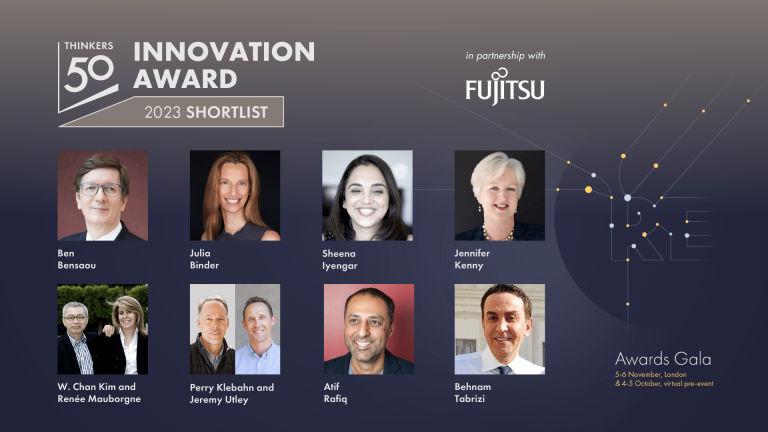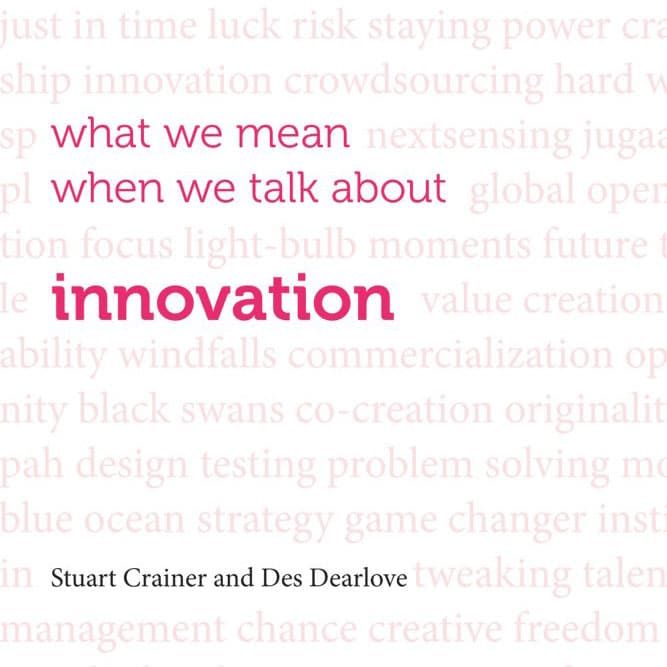

“Innovation, as a bottom-up activity, is about trying to do things that go beyond our job description. By definition, it is about taking time away from what we are officially being paid to do, in order to try something that offers uncertain pay-offs, at some time in the future, to someone else. Even if we convince ourselves that we can find the time and resources to do it, we also have to persuade those around us, and we have to push against all manner of formal procedures and systems that were designed to maintain the status quo,” says London Business School’s Julian Birkinshaw and researcher Lisa Duke. “All of this is well known. But companies still struggle with how to overcome these obstacles without compromising today’s business. The companies we studied didn’t have all the answers. Rather they had put in place an array of interventions or enablers, often used in combination, to provide the necessary resources – time, money, permission—for employees to take their new business ideas forward.”
Birkinshaw and Duke organized these into four categories:
The idea of giving employees time to carry out experiments, pursue ideas and projects is nothing new. It is based on the idea that off-beat pursuits might prove the most lucrative of all and has the motivational advantage of employees might be more engaged if given the chance to pursue their own agenda. All of this presumes that their actual work is slightly less fulfilling.
Another champion of giving people the freedom to explore is Navi Radjou, co-author of Jugaad Innovation. This form of innovation comes from the ability of people in emerging markets to adapt the materials they have to come up with solutions. Jugaad, a verb in Punjabi, is a transportation vehicle that has been built from whatever parts are available.
Explains Radjou: “So it’s like a Frankenstein kind of thing where the back of the vehicle is a bullock cart and at the front of it is a tractor engine, so it has the front of a tractor. It’s the way of transporting people from villages to cities whenever they have to go to cities. It is basically a makeshift vehicle made up of spare parts slapped together. Jugaad, then, is the ability to not reinvent the wheel all the time, but to see what you have around you already and then make the most of it.
“You need to create the space and time for people to actually have a playground. Jugaad, for me, has a kind of child-like magic in it. People are able to come up with solutions because they are not encumbered by the processes and the structures of companies. So large companies have to loosen up. They are too uptight right now, and the way you do that is you create a playground.”
Radjou suggests that one company that has done this very well is Ford which has partnered in Detroit with TechShop, the maker platform. Together they have created a big warehouse and re-purposed it as a playground where the Ford employees can go in their spare time — evenings and weekends – and play with a 3D printer, or whatever it is, without any constraints.
“What happens is that through that process, the Ford engineers were able now to come up with really innovative stuff that otherwise they would not do inside their formal R&D lab where probably there were more restrictions. Long story short, they managed to increase the amount of patentable ideas by 30 percent, and reduce the R&D spend by a significant percentage. So, literally they were able to do more with less,” says Radjou. “Jugaad only happens in a very messy environment. So the more processes, the more clean the environment is, the more innovation becomes very incremental. People take small steps, they watch their backs. But if it’s like kids in a playground, they don’t give a damn, they just go and play.
“So I think the playful nature of innovation, innovation has become too serious, put it that way. I think you need to kind of go back to that magic element, bring back that magic element of innovation.”
The best-known examples of the time out route to innovation are 3M and Google. 3M offered workers the chance of spending 15 percent of their time on personal projects. Google’s Innovation Time Off gives engineers the chance to spend up to 20 percent of their time on personal projects. It is a good idea (though difficult to manage) and one which has powerful track record of success.
But, formalizing time-outs runs the danger of missing the point of how innovation works. Compartmentalization is not innovation. Innovation often involves putting two and two together and making four. A simple idea from one place combined with a simple idea from another place can yield gold.
Take 3M’s development of the Post-it note. In 1970 Spencer Sylver of 3M invented the post-it note. But it took Arthur Fry to recognize the opportunity in 1979. The post-it remains a ubiquitous money-spinner.
Fry started working for 3M in 1953 when he was still a chemical engineering student at the University of Minnesota. His career was spent in developing new products for his highly innovative employer.
The Post-it began lie when Fry’s colleague Dr Spencer Silver in 3M’s Central Research Department came up with a weak adhesive which stuck strongly enough to keep pieces of paper together and could then be broken without leaving a mark. It was an invention in search of a use.
Fry came up with the use. As a chorister in his church choir he used pieces of paper to mark pages. These, inevitably, had a habit of falling out. “I needed a bookmark that would stay put, yet could easily be removed without damaging my hymnal,” said Fry. Then, Eureka! Fry used the adhesive to stick pieces of paper as bookmarks. “Now I had a bookmark that could stick to the page while exposing a part that wasn’t sticky,” he said. Fry then used the bookmark and adhesive to mark a report. “That’s when I came to the very exciting realization that my sticky bookmark was actually a new way to communicate and organize information.”
Of course, great ideas routinely fail in the marketplace. The Post-it, as it was called, was no exception. In 1977 it was tested in Richmond, Tulsa, Denver and Tampa. Consumers were notable by their absence – after all, no-one really knew what it could be used for.
Inspiration came when two 3M executives flew to Richmond and walked into offices to demonstrate the product. Once they knew how it could be used and the myriad of possibilities, people bought Post-its on the spot. Of the people who saw the Post-it at work, 90 percent said they’d buy.
The pilot was expanded to 11 sites. Before long Post-its were everywhere – Art Fry advertised Gap clothing as a result; George Jones mentioned them in a song; books by Dick Francis and Tom Clancy featured them, not to mention walk-on parts in Seinfeld.
Two plus two equals four, but only if you work in a culture which encourages connections to be made between different people and different ideas. Giving people space to pursue individual projects can create such links.
Resources
Stuart Crainer, 75 Greatest Management Decisions, AMACOM, 1999
This was originally published in What we mean when we talk about innovation by Stuart Crainer and Des Dearlove (Infinite Ideas, 2016).

Thinkers50 Limited
The Studio
Highfield Lane
Wargrave RG10 8PZ
United Kingdom

Thinkers50 Limited
The Studio
Highfield Lane
Wargrave RG10 8PZ
United Kingdom

| Cookie | Duration | Description |
|---|---|---|
| LANG | 9 hours | Linkedin set this cookie to set user's preferred language. |
| nsid | session | This cookie is set by the provider PayPal to enable the PayPal payment service in the website. |
| sp_landing | 1 day | The sp_landing is set by Spotify to implement audio content from Spotify on the website and also registers information on user interaction related to the audio content. |
| sp_t | 1 year | The sp_t cookie is set by Spotify to implement audio content from Spotify on the website and also registers information on user interaction related to the audio content. |
| tsrce | 3 days | PayPal sets this cookie to enable the PayPal payment service in the website. |
| x-pp-s | session | PayPal sets this cookie to process payments on the site. |
| __cf_bm | 30 minutes | This cookie, set by Cloudflare, is used to support Cloudflare Bot Management. |
| Cookie | Duration | Description |
|---|---|---|
| l7_az | 30 minutes | This cookie is necessary for the PayPal login-function on the website. |
| Cookie | Duration | Description |
|---|---|---|
| CONSENT | 2 years | YouTube sets this cookie via embedded youtube-videos and registers anonymous statistical data. |
| _ga | 2 years | The _ga cookie, installed by Google Analytics, calculates visitor, session and campaign data and also keeps track of site usage for the site's analytics report. The cookie stores information anonymously and assigns a randomly generated number to recognize unique visitors. |
| _gat_gtag_UA_10408481_1 | 1 minute | Set by Google to distinguish users. |
| _ga_ZP8HQ8RZXS | 2 years | This cookie is installed by Google Analytics. |
| _gid | 1 day | Installed by Google Analytics, _gid cookie stores information on how visitors use a website, while also creating an analytics report of the website's performance. Some of the data that are collected include the number of visitors, their source, and the pages they visit anonymously. |
| Cookie | Duration | Description |
|---|---|---|
| NID | 6 months | NID cookie, set by Google, is used for advertising purposes; to limit the number of times the user sees an ad, to mute unwanted ads, and to measure the effectiveness of ads. |
| test_cookie | 15 minutes | The test_cookie is set by doubleclick.net and is used to determine if the user's browser supports cookies. |
| VISITOR_INFO1_LIVE | 5 months 27 days | A cookie set by YouTube to measure bandwidth that determines whether the user gets the new or old player interface. |
| YSC | session | YSC cookie is set by Youtube and is used to track the views of embedded videos on Youtube pages. |
| yt-remote-connected-devices | never | YouTube sets this cookie to store the video preferences of the user using embedded YouTube video. |
| yt-remote-device-id | never | YouTube sets this cookie to store the video preferences of the user using embedded YouTube video. |
| yt.innertube::nextId | never | This cookie, set by YouTube, registers a unique ID to store data on what videos from YouTube the user has seen. |
| yt.innertube::requests | never | This cookie, set by YouTube, registers a unique ID to store data on what videos from YouTube the user has seen. |
| Cookie | Duration | Description |
|---|---|---|
| DEVICE_INFO | 5 months 27 days | No description |
| loglevel | never | No description available. |
| m | 2 years | No description available. |
Thinkers50 Limited has updated its Privacy Policy on 28 March 2024 with several amendments and additions to the previous version, to fully incorporate to the text information required by current applicable date protection regulation. Processing of the personal data of Thinkers50’s customers, potential customers and other stakeholders has not been changed essentially, but the texts have been clarified and amended to give more detailed information of the processing activities.